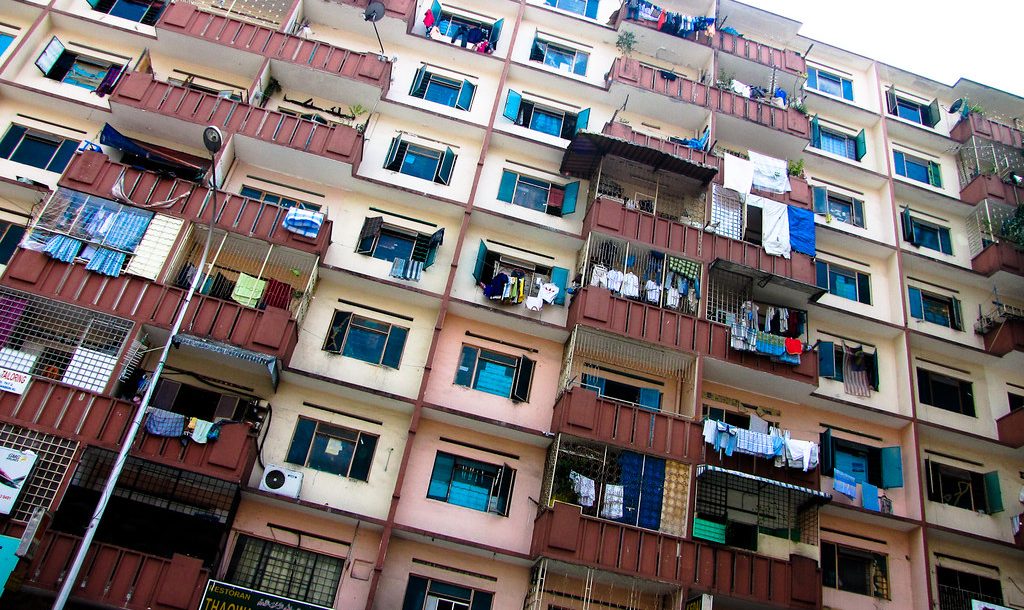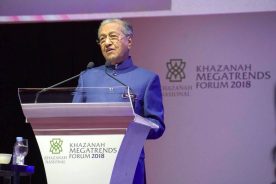According to government statistics, poverty is virtually non-existent in Malaysia—the Barisan Nasional (BN) government pegged its incidence at 0.6% of the population in 2014. But this was because the poverty line was fixed at ridiculously low levels then. It is still unrealistic now: RM920 per month for a family of two adults and three children works out to a per capita income of US$1.60 per day. A more realistic poverty line would be a household income of RM3,000 per month, which would be about 50% of the current median household income. Around 25% of Malaysian households are below this income level.
There are many who are perplexed by the persistence of poverty in Malaysia. The Malaysian economy has been growing healthily over the past fifty years, from a GDP of RM10.3 billion in 1970 to RM1.45 trillion in 2018. The economy has diversified from agricultural-commodity production to manufacturing, which contributed 23% of GDP and employed 17.9% of the work force in 2015, compared to 8.8% and 11.7%, respectively, for the agricultural sector. Moreover, Malaysia is a significant petroleum and natural gas exporter, accounting for 13% of total exports in 2018. Per capita income in real terms (after taking into account inflation) has increased ten-fold between 1970 and 2018.[1]
Moreover the BN government committed substantial resources for affirmative action to uplift the lot of the Bumiputra population (Malays and the indigenous peoples of the peninsula, Sabah, and Sarawak) since the institution of the New Economic Policy (NEP) in the 1970s. Why, then, is there still poverty in Malaysia? And why does the Bumiputra community still make up some 80% of the bottom 40% of the population (the B40) when they only constitute about 65% of the population? There are some who blame laziness—that the Bumiputra population has been spoilt by too much pampering, such that they are unable to stand on their own feet and are always expecting handouts.
But the truth is somewhat more complicated, and has a lot to do with the way that Malaysia is articulated into the global economy. Let’s examine the main aspects.
Depressed prices for agricultural commodities
There are around 172,000 padi farmers, 375,000 rubber smallholders, 275,000 oil-palm smallholders and much lower numbers of coconut, cocoa and pepper smallholders in Malaysia. Over 85% of them work on plots of less than five acres. They are all affected by the prices of their commodity on the world market, which is characterised by a marked imbalance in “market power”. A small number of buyers with deep pockets and accumulated stockpiles face off against millions of poor small farmers spread out over several countries. This inequality in market power has led to depressed commodity prices ever since the nations in Asia and Africa gained independence. This problem isn’t uniquely Malaysian—it affects millions of farmers in other third-world countries, as well, who have been and are still being “short-changed” by the international system of trade!
Business as usual: regime change and GLCs in Malaysia
Pakatan is using state enterprise as a tool of patronage just as well as Barisan.
One strategy developing countries use is going “downstream”, to process the commodity before exporting it. Malaysia has done some of that—we are now the largest producer of surgical gloves in the world. We also manufacture tyres and a host of palm-oil products such as cooking oil, soap and margarine, and that adds to our GDP. However this strategy of expanding into downstream manufacturing does not do much for the commodity price or for smallholders’ income.
A low wage economy
Factories employ 18% of the Malaysian work force. However, the vast majority of factory workers take home less than RM1,500 per month.
This is because Malaysia’s industrialisation strategy has been to offer low costs of production. The Malaysian government set up free-trade zones to attract multinationals looking for places to outsource some portions of their production chain. In addition to tax-free status for these zones, Malaysia also provides electricity at cheap rates as well as low-waged labour. The fact that the Malaysian government has taken a strong stand against trade union activism also enhanced Malaysia’s standing in the eyes of foreign investors. This strategy has succeeded: Malaysia is now the world’s largest exporter of electronic components.
But the downside of this industrialisation strategy is that Malaysia is now locked into global chains of production that use the threat of transferring production to another third-world country as a potent weapon to keep costs of production, and especially wages, low. This was the argument presented at a Malaysian National Wage Council meeting in mid-2018 that was convened to discuss setting a new minimum-wage level. The unions and Parti Sosialis Malaysia (PSM) [of which the author is a member—Ed.] argued for an increase from RM1,000 to RM1,500 per month. The employers’ federation argued that they needed to keep costs down or they would lose competitiveness. They asked that the increase be only to RM1,050. In September 2018, the government announced a national minimum monthly wage of RM1,050 as of 2019, but after workers gathered outside Parliament to protest, the government raised it to RM1,100. The fear of not being able to attract new foreign direct investment or of losing existing foreign investors to Thailand or to Vietnam, where wages are lower, has a significant impact on the minimum wage rate the government sets.
The ASEAN Trade in Goods Agreement also dampens efforts to raise the minimum wage. At present there are hardly any tariffs on the import of goods from other ASEAN countries.[4] This means that Malaysian manufacturers of consumer items—clothes, shoes, toiletries and similar items—have to contend with imports of the same products from Vietnam and Thailand. Too drastic a hike in the wage rate would make it difficult for our local factories to maintain market share. As the employers’ federation warned, workers may get a higher minimum wage—but many would lose their jobs.
Fiscal constraints to expanding the safety net
An effective modality of sharing the wealth of the nation is by subsidising essential services and instituting cash-transfers to sectors in need. Malaysia has already gone some way down that road, as the 2019 federal budget suggests:
- Education is practically free from primary to secondary level. The fees charged are minimal—between RM100 and RM200 per year. Most primary school children are supplied with free textbooks. Parents only need to cover the cost of school clothes, transport and canteen meals. The Ministry of Education was allocated RM60.2 billion in the 2019 budget, 19.1% of the total.
- The Ministry of Health, which has a budget of RM29 billion (9.2% of the total) maintains 2,860 health clinics, distributed throughout the nation, as well 141 hospitals. In 2017, there were a total of 2.37 million admissions to government hospitals, compared to 1.05 million admissions to private hospitals.
- The Ministry of Women, Family and Community Development, with a budget of RM2.4 billion, gives financial aid to some single mothers, old persons without family support and severely incapacitated individuals. The quantum isn’t much—usually less than RM400 per month—but still does provide significant relief for the families that receive this help.
- The Ministry of Agriculture (2019 budget: RM4.4 billion) has several programs targeting padi farmers. The padi-production incentive scheme pays out an additional 75 cents per kilogram of padi that the farmer sells to the mill, thereby doubling his earnings. (RM281 million has been allocated for this scheme for 2019.) Fertilisers and pesticides are provided free to padi farmers (with a budget allocation of RM232 million). The previous government gave around 70,000 traditional fishermen a monthly stipend of RM300.
- The Ministry of Rural Development (2019 budget: RM8.4 billion) provides infrastructure for the rural population—bridges, roads, community centres—and helps in repairing or even building houses for the rural poor.
There are suggestions that this safety net could be widened. Specific suggestions include:
- Old-age pensions. At present only government servants (who constitute 15% of the working population) can look forward to old-age pensions. 6.5 million Malaysian workers are contributors to the Employment Provident Fund (EPF)—they contribute 11% of their wages monthly while their employer contributes 13%. However, since wages are low, a survey in 2016 found that only 22% of EPF contributors aged 54 years and above had RM196,800 or more in their savings, which translates to about RM820 monthly during retirement. There are another 5 million working people who are on neither the pension scheme nor the EPF scheme.
The suggestion is that all Malaysians aged above 70 years who are not on government or SOCSO pensions should be given RM300 monthly. This would require a budget of RM3 billion per year currently, and would increase as the population ages.
- Increasing the health budget to 4% of GDP. That would require an extra RM29 billion. The rationale for the increase is that government hospitals and clinics are severely overcrowded and wait times to see specialists are long. This has forced quite a number of people to turn to the private sector, which is expensive.
- Subsidised tertiary education. At present college students can take loans from a government-run agency, the PTPTN. A three-year degree course in a private university will saddle the graduate with an RM70,000 loan. The proposal is to reduce fees drastically by giving grants amounting to 90% of academic fees. This would require approximately RM13 billion per year.[5]
- Subsidised bus-based public transport in all our towns and cities. This will reduce transport costs as well as Malaysia’s carbon footprint, and is a much cheaper alternative to building train-based transit systems.
- Monthly cash transfers of RM300 to the poorest 20% of households—the cost would be RM4.5 billion.[6]
There are also suggestions, among others, to increase the budget of the Department of Welfare, increase the stipend given to single mothers, provide subsidised housing to the population, and take over the maintenance of low-cost residential flats (many of which are in a deplorable state).
The problem here is that all these good ideas, that will undoubtedly alleviate the financial pressures on the bottom half of our population, require additional funds. Total federal revenue for 2019 is estimated at RM261.8 billion. But the total budgetary allocation for 2019 is RM314.5 billion. That means RM52.7 billion has to be borrowed—a fiscal deficit of 3.4% of GDP for 2019. (The Malaysian GDP in 2019 is projected to be RM1.55 trillion.) Given the fact that federal-government debt is about RM750 billion, the government needs to sell securities worth about RM75 billion in the course of 2019 to roll over the bonds and securities that are maturing this year. This is in addition to the RM52.7 billion that has to be raised to meet this year’s budget shortfall.
I am quoting all these figures to drive home the point that there are real limitations to a strategy of building a more comprehensive safety-net on the back of a larger budgetary deficit. Doing so will impact negatively on our credit rating and drive up the costs of borrowing. Malaysia allocated RM30.88 billion, or 10.9% of the total federal budget, for debt servicing in 2018, to pay the interest on government bonds and securities. This works out to an average interest rate of 4.1%. The interest we will have to pay on future debt will increase if our budget deficit increases from its current 3.4%.
Fiscal prudence dictates that the government has to raise additional revenue if it decides to embark on augmented social spending. A consumption tax is politically out of the question at present. The Pakatan Harapan (PH) government came in on the campaign promise that it would abolish the GST (goods and services tax) and it has done so. It cannot now reinstitute this tax. And in any case, such a tax is regressive, as poorer families spend a larger portion of their income than do better-off families, who save or invest a portion of their income.
The government also faces problems in raising corporate taxes, as that might lead to companies’ shifting their headquarters to other countries. A competent accountant can transfer company earnings out of Malaysia into the accounts of the HQ located in a tax haven using a variety of techniques—routing purchase of intermediate products with hiked-up prices through the HQ, routing exports through the HQ but at discounted prices, charging large royalties and fees for accounting and other consulting services—and all of these are quite legal, given the liberalised financial environment. All these tricks will ensure corporations declare minimal profits in Malaysia.
Malaysia had a corporate tax rate of 40% before, but starting in 1988, we began to reduce it. Other countries in the region were at lower rates and Malaysia was afraid that we would lose out on FDI (foreign direct investment). As a result corporate tax in Malaysia is now at 24% and the Minister of Finance has said he will reduce this even further soon! The reason is that Singapore only has an 18% corporate tax rate, and Thailand, 19%. It is a classic “race to the bottom” scenario that has unfolded over the past 30 years and shows no sign of abating.
So, this then is the situation that Malaysia finds itself in. A significant portion of the wealth created in Malaysia is transferred out by unfair pricing mechanisms (perhaps 40% or so), through low commodity prices and low wages, and we have to make do with the remainder left to us. But our hands are tied because Malaysia is deeply integrated into the global economy. The value of our exports was 74% of our GDP in 2017. (This doesn’t mean we exported 74% of what we produced, because we imported significant quantities of chips and other components for our manufacturing sector to process and re-export.) We are definitely in no position to tell off the global chains and “de-link” from the global economy! Greece couldn’t do so in 2015, despite Syriza’s being in power, and Britain, a much larger and richer country, is facing enormous problems in trying to partially de-link from the EU.
The way forward, I believe, is to gradually and collectively renegotiate our terms of engagement with the global economy. For example, can tax havens be closed? Can we bring in legislation to restrict transfer pricing? Can we get the richest 0.01% to pay their fair share of taxes? In this matter we would have the support of the majority of the population in other countries, including in the economically advanced countries, which are also struggling with huge sovereign debts and are being forced to reduce social spending.
Can we stop the ruinous race-to-the-bottom in corporate tax rates among ASEAN countries? This is doable and perhaps should be linked to the ASEAN Free Trade Agreement—for example if any ASEAN country reduced corporate taxes further, its exports to other ASEAN countries would be charged a tariff of 5% for every 1% decrease in the corporate tax rate. In a similar manner, can we agree on jointly raising our minimum wage—by 10% next year from whatever the current base is—so that we can help the poorest in our population without suffering a comparative disadvantage in terms of FDI and market competitiveness?
Can these sorts of initiatives be canvassed in the Group of 77 and further initiatives be developed?
These are the kinds of issues we need to discuss if we want to end persistent poverty in this country. However the current PH government doesn’t seem to have explored this line of reasoning.
 Facebook
Facebook  Twitter
Twitter  Soundcloud
Soundcloud  Youtube
Youtube  Rss
Rss 



